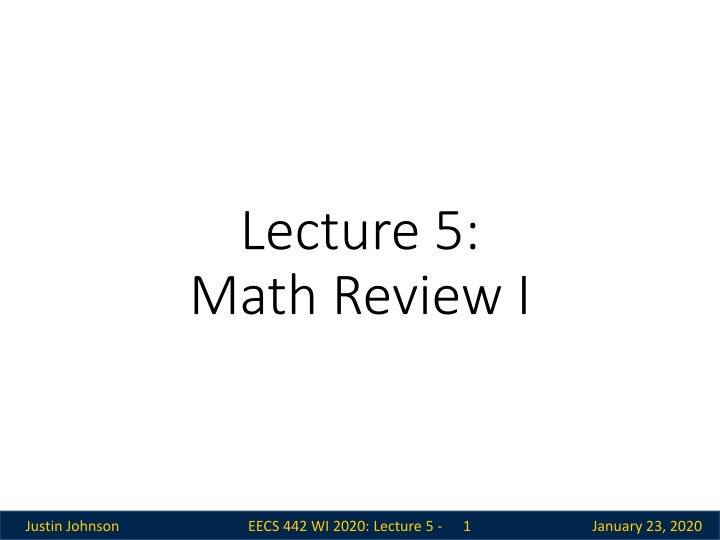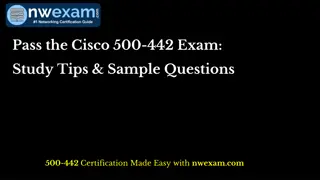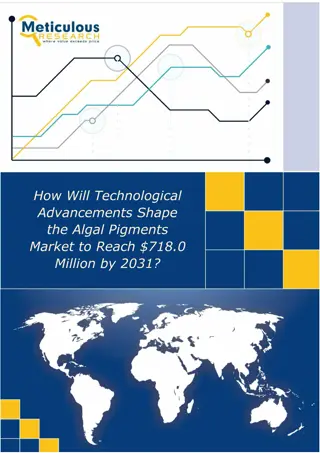
Justin Johnson EECS 442 WI 2020 Lecture 5 Review
Dive into Justin Johnson's lecture on Math Review I, covering topics like floating point arithmetic, practical math, and the Free Drinks in Vegas Theorem. Gain insights into math concepts to enhance your understanding of computer science.
Download Presentation

Please find below an Image/Link to download the presentation.
The content on the website is provided AS IS for your information and personal use only. It may not be sold, licensed, or shared on other websites without obtaining consent from the author. If you encounter any issues during the download, it is possible that the publisher has removed the file from their server.
You are allowed to download the files provided on this website for personal or commercial use, subject to the condition that they are used lawfully. All files are the property of their respective owners.
The content on the website is provided AS IS for your information and personal use only. It may not be sold, licensed, or shared on other websites without obtaining consent from the author.
E N D
Presentation Transcript
Lecture 5: Math Review I Justin Johnson 1 January 23, 2020 EECS 442 WI 2020: Lecture 5 -
Administrative HW0 due Wednesday 1/29 (1 week from yesterday) HW1 out yesterday, due Wednesday 2/5 (3 weeks from yesterday) Justin Johnson 2 January 23, 2020 EECS 442 WI 2020: Lecture 5 -
Floating Point Arithmetic Justin Johnson 3 January 23, 2020 EECS 442 WI 2020: Lecture 5 -
This Lecture and Next: Math Two goals for the next two classes: Math with computers Math Practical math you need to know but may not have been taught Justin Johnson 4 January 23, 2020 EECS 442 WI 2020: Lecture 5 -
This Lecture and Next: Goal Not a Linear algebra in two lectures that s impossible. Some of this you should know! Aimed at reviving your knowledge and plugging any gaps Aimed at giving you intuitions Justin Johnson 5 January 23, 2020 EECS 442 WI 2020: Lecture 5 -
Adding Numbers 1 + 1 = ? Suppose ?? is normally distributed with mean ? and standard deviation ? for 1 ? ? ? ? ?=? ? How is the average, or ? = (qualitatively), in terms of variance? The Free Drinks in Vegas Theorem: ? has mean ? and standard deviation ? ??, distributed ? . Justin Johnson 6 January 23, 2020 EECS 442 WI 2020: Lecture 5 -
Free Drinks in Vegas Each game/variable has mean $0.10, std $2 100K games is guaranteed profit: 99.999999% lowest value is $0.064. $0.01 for drinks $0.054 for profits 100 games is uncertain and fun! Justin Johnson 7 January 23, 2020 EECS 442 WI 2020: Lecture 5 -
Lets make it big What should happen qualitatively? Theory says that the average is distributed with mean 31 and standard deviation 1 50? 10 5 What will happen? Reality: 17.47 Justin Johnson 8 January 23, 2020 EECS 442 WI 2020: Lecture 5 -
Trying it out Hmm. Hmm. Justin Johnson 9 January 23, 2020 EECS 442 WI 2020: Lecture 5 -
What is a number? 2726252423222120 1 0 1 1 1 0 0 1 185 185 128 + 32 + 16 + 8 + 1 = Justin Johnson 10 January 23, 2020 EECS 442 WI 2020: Lecture 5 -
Adding two numbers 28 27 1 0 0 26 0 1 0 25 1 1 1 24 1 0 0 23 1 1 0 22 0 0 0 21 0 0 1 20 1 185 1 105 0 1 34 Carry Flag Result Integers on a computer are integers modulo 2k Justin Johnson 11 January 23, 2020 EECS 442 WI 2020: Lecture 5 -
Some Gotchas 32 + (3 / 4) x 40 = 32 + (3 x 40) / 4 = Underflow 32 62 Why? No Underflow 32 + (3 / 4) x 40 = 32 + 0 x 40 = 32 + 0 = 32 32 + (3 x 40) / 4 = 32 + 120 / 4 = 32 + 30 = 62 Ok you have to multiply before dividing Justin Johnson 12 January 23, 2020 EECS 442 WI 2020: Lecture 5 -
Some Gotchas Should be: 9x4=36 32 + (9 x 40) / 10 = 68 math 32 + (9 x 40) / 10 = 42 uint8 Overflow Why 104? 9 x 40 = 360 360 % 256 = 104 32 + 9 x 40 / 10 = 32 + 104 / 10 = 32 + 10 = 42 Justin Johnson 13 January 23, 2020 EECS 442 WI 2020: Lecture 5 -
What is a number? 27 1 26 0 25 1 24 1 23 1 22 0 21 0 20 1 185 How can we do fractions? 2524232221202-12-2 1 0 1 1 1 0 0 1 45.25 45 0.25 Justin Johnson 14 January 23, 2020 EECS 442 WI 2020: Lecture 5 -
Fixed-Point Arithmetic 25 1 24 0 23 1 22 1 21 1 20 0 2-1 0 2-2 1 45.25 What s the largest number we can represent? 63.75 Why? How precisely can we measure at 63? 0.25 How precisely can we measure at 0? 0.25 Fine for many purposes but for science, seems silly Justin Johnson 15 January 23, 2020 EECS 442 WI 2020: Lecture 5 -
Floating Point Numbers Sign (S) Exponent (E) Fraction (F) 1 0 1 1 1 0 0 1 1 7 1 1+1/8 = 1.125 27-7 = 20 =1 -1 ? +? ?? ??+???? ?? Bias: allows exponent to be negative (bias = -127 for float32) Note: fraction = significant = mantissa; exponents of all ones or all zeros are special numbers Justin Johnson 16 January 23, 2020 EECS 442 WI 2020: Lecture 5 -
Floating Point Numbers Fraction 0 0 0 -20 x 1.00 = -1 0 0 1 -20 x 1.125 = -1.125 0 1 0 0/8 1/8 Sign Exponent -20 x 1.25 = -1.25 2/8 1 0 1 1 1 -1 7-7=0 *(-bias)* 1 1 0 1 1 1 -20 x 1.75 = -1.75 6/8 -20 x 1.875 = -1.875 7/8 Justin Johnson 17 January 23, 2020 EECS 442 WI 2020: Lecture 5 -
Floating Point Numbers Fraction 0 0 0 -22 x 1.00 = -4 0 0 1 -22 x 1.125 = -4.5 0 1 0 -22 x 1.25 = -5 0/8 1/8 Sign Exponent 2/8 1 1 0 0 1 -1 9-7=2 *(-bias)* 1 1 0 1 1 1 -22 x 1.75 = -7 6/8 -22 x 1.875 = -7.5 7/8 Justin Johnson 18 January 23, 2020 EECS 442 WI 2020: Lecture 5 -
Floating Point Numbers Fraction Sign Exponent 0 0 0 0 0 1 -20 x 1.00 = -1 1 0 1 1 1 -20 x 1.125 = -1.125 0 0 0 0 0 1 -22 x 1.00 = -4 1 1 0 0 1 -22 x 1.125 = -4.5 Gap between numbers is relative, not absolute Justin Johnson 19 January 23, 2020 EECS 442 WI 2020: Lecture 5 -
Adding Floating Point Numbers Sign 1 Exponent 0 1 1 0 Fraction 0 0 0 -2-1 x 1.00 = -0.5 1 1 0 0 1 0 0 0 -22 x 1.00 = -4 1 1 0 0 1 0 0 1 -22 x 1.125 = -4.5 Actual implementation is complex Justin Johnson 20 January 23, 2020 EECS 442 WI 2020: Lecture 5 -
Adding Floating Point Numbers Sign 1 Exponent 0 1 0 0 Fraction 0 0 0 -2-3 x 1.00 = -0.125 1 1 0 0 1 0 0 0 -22 x 1.00 = -4 -22 x 1.03125 = -4.125 1 1 0 0 1 0 0 0 -22 x 1.00 = -4 ? 1 1 0 0 1 0 0 1 -22 x 1.125 = -4.5 Justin Johnson 21 January 23, 2020 EECS 442 WI 2020: Lecture 5 -
Adding Floating Point Numbers Sign 1 Exponent 0 1 0 0 Fraction 0 0 0 -2-3 x 1.00 = -0.125 1 1 0 0 1 0 0 0 -22 x 1.00 = -4 -22 x 1.03125 = -4.125 1 1 0 0 1 0 0 0 -22 x 1.00 = -4 For a and b, these can happen a + b = aa+b-a b Justin Johnson 22 January 23, 2020 EECS 442 WI 2020: Lecture 5 -
Real Floating Point Numbers IEEE 754 Single Precision / Single / float32 8 bits 2127 1038 23 bits 7 decimal digits S Exponent Fraction IEEE 754 Double Precision / Double / float64 11 bits 21023 10308 52 bits 15 decimal digits Exponent Fraction S Justin Johnson 23 January 23, 2020 EECS 442 WI 2020: Lecture 5 -
Real Floating Point Numbers IEEE 754 Half Precision / Half / float16 5 bits 232 109 10 bits 3 decimal digits S Exponent Fraction Brain Floating Point / bfloat16 8 bits 2127 1038 7 bits 2 decimal digits S Exponent Fraction Same range as FP32, but reduced precision Justin Johnson 24 January 23, 2020 EECS 442 WI 2020: Lecture 5 -
Trying it out Roundoff error occurs a+b=a -> numerator is stuck, denominator isn t Justin Johnson 25 January 23, 2020 EECS 442 WI 2020: Lecture 5 -
Things to Remember Computer numbers aren t math numbers Overflow, accidental zeros, roundoff error, and basic equalities are almost certainly incorrect for some values Floating point defaults and numpy try to protect you. Generally safe to use a double and use built-in- functions in numpy (not necessarily others!) Spooky behavior = look for numerical issues Justin Johnson 26 January 23, 2020 EECS 442 WI 2020: Lecture 5 -
Vectors Justin Johnson 27 January 23, 2020 EECS 442 WI 2020: Lecture 5 -
Vectors [2,3] = 2 x [1,0] 2 x 2 x + 3 x [0,1] + 3 x + 3 x e1 e2 x = [2,3] Can be arbitrary # of dimensions (typically denoted Rn) Justin Johnson 28 January 23, 2020 EECS 442 WI 2020: Lecture 5 -
Scaling Vectors Can scale vector by a scalar Scalar = single number Dimensions changed independently Changes magnitude / length, does not change direction. 2x = [4,6] x = [2,3] Justin Johnson 29 January 23, 2020 EECS 442 WI 2020: Lecture 5 -
Adding Vectors Can add vectors Dimensions changed independently Order irrelevant Can change direction and magnitude x = [2,3] x+y = [5,4] y = [3,1] Justin Johnson 30 January 23, 2020 EECS 442 WI 2020: Lecture 5 -
Scaling and Adding 2x+y = [7,7] Can do both at the same time x = [2,3] y = [3,1] Justin Johnson 31 January 23, 2020 EECS 442 WI 2020: Lecture 5 -
Measuring Length Magnitude / length / (L2) norm of vector 1/2 ? 2 ? = ?2= ?? ? There are other norms; assume L2 unless told otherwise x = [2,3] ?2= ?2= 13 10 y = [3,1] Why? Justin Johnson 32 January 23, 2020 EECS 442 WI 2020: Lecture 5 -
Normalizing a Vector Diving by norm gives something on the unit sphere (all vectors with length 1) x = [2,3] ? = ?/ ?? y = [3,1] ? = ?/ ?? Justin Johnson 33 January 23, 2020 EECS 442 WI 2020: Lecture 5 -
Dot Products ? ???? = ??? ? ? = ?=1 ? ? = cos ? ? ? What happens with normalized / unit vectors? ? ? ? Justin Johnson 34 January 23, 2020 EECS 442 WI 2020: Lecture 5 -
Dot Products ? ? = [2,3] ? ? = ???? ? What s? ??, ? ??? Ans: ? ??= 2 ; ? ??= 3 Dot product is projection Amount of xthat s also pointing in direction of y ?? ?? Justin Johnson 35 January 23, 2020 EECS 442 WI 2020: Lecture 5 -
Dot Products ? ? = [2,3] ? ? = ???? ? What s? ? ? Ans: ? ? = ????= ?2 2 Justin Johnson 36 January 23, 2020 EECS 442 WI 2020: Lecture 5 -
Special Angles 1 0 0 = 0 1 + 1 0 = 0 1 ? Perpendicular / orthogonal vectors have dot product 0 irrespective of their magnitude ? ? ? ? Justin Johnson 37 January 23, 2020 EECS 442 WI 2020: Lecture 5 -
Special Angles ?1 ?2 ?1 ?2 = ?1?1+ ?2?2= 0 ? Perpendicular / orthogonal vectors have dot product 0 irrespective of their magnitude ? ? ? ? Justin Johnson 38 January 23, 2020 EECS 442 WI 2020: Lecture 5 -
Orthogonal Vectors ? = [2,3] Geometrically, what s the set of vectors that are orthogonal to x? A line [3,-2] Justin Johnson 39 January 23, 2020 EECS 442 WI 2020: Lecture 5 -
Orthogonal Vectors ? What s the set of vectors that are orthogonal to x = [5,0,0]? A plane/2D space of vectors/any vector [0,?,?] What s the set of vectors that are orthogonal to x and y = [0,5,0]? A line/1D space of vectors/any vector [0,0,?] Ambiguity in sign and magnitude ? ? Justin Johnson 40 January 23, 2020 EECS 442 WI 2020: Lecture 5 -
Cross Product Set {?:? ? = 0,? ? = 0} has an ambiguity in sign and magnitude Cross product ? ?is: (1) orthogonal to x, y (2) has sign given by right hand rule and (3) has magnitude given by area of parallelogram of x and y Important: if x and y are the same direction or either is 0, then ? ? = ? Only in 3D! (See wedge product for D != 3) ? ? ? ? Image credit: Wikipedia.org Justin Johnson 41 January 23, 2020 EECS 442 WI 2020: Lecture 5 -
Operations You Should Know Scale (vector, scalar vector) Add (vector, vector vector) Magnitude (vector scalar) Dot product (vector, vector scalar) Dot products are projection / angles Cross product (vector, vector vector) Vectors facing same direction have cross product 0 0 You can never mix vectors of different sizes Justin Johnson 42 January 23, 2020 EECS 442 WI 2020: Lecture 5 -
Next Time: Matrices, Vectorization, Linear Algebra Justin Johnson 43 January 23, 2020 EECS 442 WI 2020: Lecture 5 -






